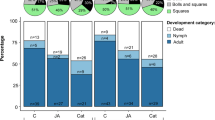Abstract
Female moths of the tobacco budworm,Heliothis virescens (F.), oviposit in the terminals of the cotton plant,Gossypium hirsutum (L.). The hatched larvae migrate to the terminal area and then to small squares (buds), on which they feed, finally burrowing into the anthers where they grow and develop. They attempt to avoid gossypol glands as they feed. Chemically related evidence explains, in part, these observations. The calyx crown of resistant lines (which is avoided) is high in the terpenoid aldehydes (TAs) including gossypol. HPLC data showed that the gossypol content of both susceptible and resistant glanded lines is equal, while the hemigossypolone and heliocides H1 and H2 are greatly increased in resistant lines and presumably are more closely associated with resistance. Analysis for total amino acids in cotton square tissues showed that there was a gradation from the calyx and calyx crown, which were lowest, to the anthers, the site of final insect development, which were highest. Synthetic diets mimicking amino acid distribution in anthers were found to be successful for larval growth and development.
Similar content being viewed by others
References
Chan, B.G., Waiss, A.C., Binder, R.G., andElliger, C.A. 1978. Inhibition of lepidopterous larval growth by cotton constituents.Entomol. Exp. Appl. 24:94–100.
Cohen, S.A., Bidlinomeyer, B.A., andTarvin, T.L. 1986. PITC derivatives in amino acid analysis.Nature 320: 769–770.
Collum, D.H., Hedin, P.A., White, W.H., Parrott, W.L., Jenkins, J.N., andGrimley, E.B. 1981. Studies on the structural properties of cotton tannin and its toxicity to the tobacco budworm. Abstracts of Papers, 182nd National Meeting of the American Chemical Society, New York. American Chemical Society, Washington, D.C. Pest Abstract No. 54.
Dadd, R.H. 1985. Nutrition: Organisms, pp. 313–390,in G.A. Kerbut and L.I. Gilbert (eds.). Insect Physiology, Biochemistry, and Pharmocology, Vol. 4, Regulation, Digestion, Nutrition, Excretion. Pergamon Press, Elmsford, New York.
Hedin, P.A., andMcCarty, J.C. 1990. Possible Roles of Cotton and sugars and terpenoids in oviposition by the boll weevil.J. Chem. Ecol. 16:757–772.
Hedin, P.A., Jenkins, J.N., Collum, D.H., White, W.H., Parrott, W.L., andMacGown, M.W. 1983a. Cyanidin-3-β-glucoside, a newly recognized basis for resistance in cotton to the tobacco budworm.Experientia 39:799–801.
Hedin, P.A., Jenkins, J.N., Collum, D.H., White, W.H., andParrott, W.L. 1983b. Multiple factors in cotton contributing to resistance to the tobacco budworm. pp. 349–365,in P.A. Hedin (ed.). Plant Resistance to Pests. ACS Symposium Series 208, American Chemical Society, Washington, D.C.
Hedin, P.A., Parrott, W.L., Jenkins, J.N., Mulrooney, J.E., andMenn, J.J. 1988. Elucidating mechanisms of tobacco budworm resistance to allelochemicals by dietary tests with insecticide synergists.Pest Biochem. Physiol. 32:55–61.
Hedin, P.A., Williams, W.P., Davis, F.M., andBuckley, P.M. 1990. Roles of amino acids, protein, and fiber in leaf-feeding resistance of corn to the fall armyworm.J. Chem. Ecol. 16:1977–1995.
Horwitz, W. (ed.). 1975. Methods of Analysis of the Association of Official Analytical Chemists, 12th ed. 1094 pp. Association of Official Analytical Chemists, Washington, D.C.
Jenkins, J.N., Parrott, W.L., McCarty, J.C., Jr., andWhite, W.H. 1982. Breeding cotton for resistance to the tobacco budworm: Techniques to achieve uniform field infestation.Crop Sci. 22:400–404.
Lindig, O.H., Poe, W.E., andHedin, P.A. 1980. Essential amino acids in dietary protein sources and the nutritional status and oviposition of boll weevils.J. Econ. Entomol. 73:172–175.
Parrott, W.L., Maxwell, F.G., Jenkins, J.N., andMauldin, J.K. 1969. Amino acids in hosts and non-hosts of the boll weevil.Ann. Entomol. Soc. Am. 62:255–260.
Parrott, W.L., Jenkins, J.N., andMcCarty, J.C. 1983. Feeding behavior of first-stage tobacco budworm on three cotton cultivars.Ann. Entomol. Soc. Am. 76:167–170.
Parrott, W.L., Jenkins, J.N., Mulrooney, J.E., McCarty, J.C., andShepherd, R.L. 1989. Relationship between gossypol gland density on cotton squares and resistance to tobacco budworm larvae.J. Econ. Entomol. 82:589–592.
Phillips, V.A., andHedin, P.A. 1990. Spectral techniques for structural analyses of the cotton terpenoid aldehydes gossypol and gossypolone.J. Agric. Food Chem. 38:525–528.
Ramalho, F.S. 1983. Behavior of the tobacco budworm in cotton. PhD dissertation. Mississippi State University, Mississippi State, Mississippi.
Ramalho, F.S., McCarty, J.C., Jr., Jenkins, J.N., andParrott, W.L. 1984. Distribution of tobacco budworm (Lepidoptera: Noctuidae) larvae within cotton plants.J. Econ. Entomol. 77:591–594.
SAS. 1985. SAS User's Guide: Statistics, Version 5 Edition, SAS Institute, Inc., Cary, North Carolina. 956 pp.
Shaver, T.N., andParrott, W.L. 1970. Relationship of larval age to toxicity of gossypol to bollworms, tobacco budworm, and pink bollworms.J. Econ. Entomol. 63:1802–1804.
Shaver, T.N., Garcia, K.A., andDilday, R.H. 1977. Tobacco budworm: Feeding and larval growth on component parts of cotton flowerbuds.J. Envirn. Entomol. 6:82–84.
Stipanovic, R.D., Bell, A.A., O'Brien, D.H., andLukefahr, M.J. 1977. Heliocide H2: An insecticidal sesterterpenoid from cotton (Gossypium).Tetrahedron Lett. 6:567–570.
Stipanovic, R.D., Bell, A.A., O'Brien, D.H., andLukefahr, M.J. 1978. Heiiocide H,: A new insecticidal sesterterpenoid from cotton (Gossypium hirsutum).J. Agric. Food Chem. 26:115.
Stipanovic, R.D., Altman, D.W., Begin, D.L., Greenblatt, G.A., andBenedict, J.H. 1988. Terpenoid aldehydes in upland cottons: Analysis by aniline and HPLC methods.J. Agric. Food Chem. 36:509–515.
Vanderzant, E.S. 1965. Axenic rearing of the boll weevil on defined diets: amino acid, carbohydrate and mineral requirements.J. Insect Physiol. 11:659–670.
Author information
Authors and Affiliations
Rights and permissions
About this article
Cite this article
Hedin, P.A., Parrott, W.L. & Jenkins, J.N. Effects of cotton plant allelochemicals and nutrients on behavior and development of tobacco budworm. J Chem Ecol 17, 1107–1121 (1991). https://doi.org/10.1007/BF01402937
Received:
Accepted:
Issue Date:
DOI: https://doi.org/10.1007/BF01402937




